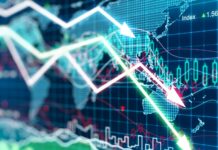Buy Gold, Buy Silver, Invest In Commodities
February 27 (King World News)
Dr. Stephen Leeb: Russia’s invasion of Ukraine is another compelling reason to own all the gold you can. It will intensify commodity scarcities while raising the specter of an unintended catastrophic escalation – a one/two punch that virtually ensures higher, and like much higher, gold prices lie ahead.
At the same time, you could also say that the odds of a long-term bull market in gold, or in any top performing asset, have been reduced simply because anything posing an existential threat to humanity is a fortiori a threat to any trend’s longevity. And I’m not thinking primarily here of the possibility of nuclear conflict. That still appears remote, since the catastrophic short-term effects are so clear for all to see.
Rather, I’m referring to how Russia’s attack on Ukraine exacerbates the longer-term existential threat of resource scarcities and climate change – which if we don’t successfully confront, could ultimately make this planet inhospitable for human civilization. It makes it even more urgent for the world to cooperate on a large scale to confront these scarcities, and to do so quickly, before it’s too late – before we slip into a vicious circle in which fighting over commodities leads to greater scarcities and in turn more wars…
I profoundly hope that recent events will be a wake-up call, and maybe they will. At the moment, the world has mostly come together in condemnation of Russia’s actions. But whether a more unified West and a perhaps chastised Putin leads to greater overall worldwide cooperation is anything but clear.
Commodity scarcities likely always were part of Putin’s calculus and he probably saw them as strengthening his hand, given that Russia is rich in so many resources including energy and critical metals such as palladium. The West could have taken this more into account in dealing with Putin prior to the conflict. Going forward, it’s pretty clear that conflict with a county rich in important commodities ranging from grains to specialized gasses essential for the semiconductor industry will sharply exacerbate commodity scarcities, affecting worldwide commerce.
The reality, however frustrating, is that we’re all in this together, authoritarian and democratic societies alike. The biggest long-term threats aren’t country-specific, because worsening resource scarcities are a threat to the well-being of all humanity. And the longer global cooperation remains elusive, the worse the threats become.
Do Not Trust Paper Price Being Quoted For Commodities
Evidence of resource scarcities is pervasive and can be seen on a chart of nearly any commodity. The commodity indexes I pay most attention to are spot indexes that report on actual prices paid by end users. These are a better guide to what is going on than paper and future prices, which are subject to speculation and even manipulation. The CRB spot indices of foodstuffs, raw industrials, and all commodities (including foods, industrials, and energy) have all been on a tear since the first quarter of 2020. By the end of January, all three not only were at all-time highs, they had climbed at a rate unmatched in modern times. Most glaring was that the index of food items had nearly doubled. Remarkably, the rate of ascent is nearly as great for the other indexes.
Gains in commodities are a major reason inflation has jumped in the West. Based on past history up to 2010, or maybe even a few years later, it’s easy to see why the Fed and others viewed the commodity gains and associated gaps in supply chains as one-off events, leading to the mistaken view that inflation would be transitory. After all, commodity uptrends have been relatively short-lived not just in this century but throughout history as far back as at least the 15th century. In fact, that’s why the CPI is reported as both a single number and a number, called “core” inflation, that excludes food and energy – changes in the prices of those most basic commodities are seen as ephemeral, the result largely of non-systemic economic factors.
But this ignores a key change I’ve discussed before. According to the World Bank, in 2015, for the first time, in terms of purchasing power parity the aggregate GDP of low- and middle-income countries – the goods they produced and consumed– surpassed that of high-income countries. Two years later, by the same measure, China’s GDP alone surpassed that of the U.S. While China is clearly the biggest chunk of the rest of the world group and the catalyst for its dramatic growth, China still has only 30% of the group’s population. Overall, the high-income group accounts for less than 15% of the world’s population, yet until 2015 it had a GDP higher than the rest of the world…
While 2015 was the most visible marker for lesser-income countries becoming the driver of world growth, the shift was visible earlier this century as the gap between those countries and high-income countries began to narrow. By 2020 the GDP of the lesser-income groups had surpassed the high-income group by about 10%.
Why does all this matter? When the GDPs of the two groups crossed in 2015, per-capita income in the high-income countries was more than five times that of the less wealthy part of the world. Lower per-capita GDP means lower per-capita use of natural resources. The accelerating growth in the lesser-income group means demand for natural resources will be much more leveraged to worldwide growth than ever before.
According to the U.N., high-income countries on a per-capita basis consume three times more natural resources than the rest of the world. But what’s more important is that per-capita growth in natural resource consumption is much faster in lower-income countries. Indeed, high-income countries experience very little growth in per-capita natural resource consumption, while in lower-income countries, natural resource consumption has grown by more than 30% in the past 20 years. When you combine this with population growth, total growth in natural resource consumption is much higher than it has ever been. Between 2000 and 2020, the world’s need for natural resources climbed by nearly 35 billion tons, to more than 85 billion tons. More than 95% of that growth came from the lower-income countries.
Greatest Ever Increase In Commodity Usage
The spike in world growth during 2021 likely led to the greatest ever increase in use of commodities that the world has ever experienced. Keep in mind that even steady consumption of commodities will sooner or later lead to scarcities. Prior to 2000, the most important contributor to the growth in natural resource consumption was population growth, as per-capita growth in usage in the lower-income countries was a fraction of 1%. That total growth was in line with high-income countries was due to much faster growth in population.
If this seems complicated, looking just at energy, where longer-term data is more available, may help explain these trends more clearly. Between 1980 and 2000, demand for energy rose by the equivalent of 2.4 billion barrels of oil. Between 2000 and 2020, the increase was double, about 5.8 billion barrels, with the entire gain coming from the lesser-income groups. These trends in commodity consumption are here to stay and strongly imply growing resource scarcities. The gigantic jump in resource demand during the past 18 months is not transitory and indeed is likely to accelerate over the next two decades.
Finally, realize that the vast bulk of commodities is produced within the lower-income countries and that commodity production in high-income groups is barely profitable. In the lower-income countries, commodity production on balance remains profitable in that they have used only a small portion of their endowment.
This has left the U.S. increasingly dependent on other countries, especially those with large endowments of commodities. We will desperately need these countries not only to maintain our living standards but to transition to a sustainable world. Global cooperation is essential. We all have critical roles to play in coming decades if humanity is going to continue to have a home on this planet.
Which brings us back to Ukraine. Some have argued that NATO’s expansion eastward, with the possibility of Ukraine someday becoming a member, was a mistake by the U.S. and the West. Perhaps so, but it changes nothing on the ground today. What counts is what we and the world do going forward to recognize the long-term threats and to come together in confronting them.
Buy Gold, Don’t Trust The Banks
The world is being tested to the extreme. Cooperation is necessary to pass the test. Right now, as individuals, the best thing you can do for yourself is to buy protection, and that means investing in gold. Even under the best scenarios, a lot of turmoil lies ahead before we reach the other side, and gold will be the best way to get through it in good shape.






























